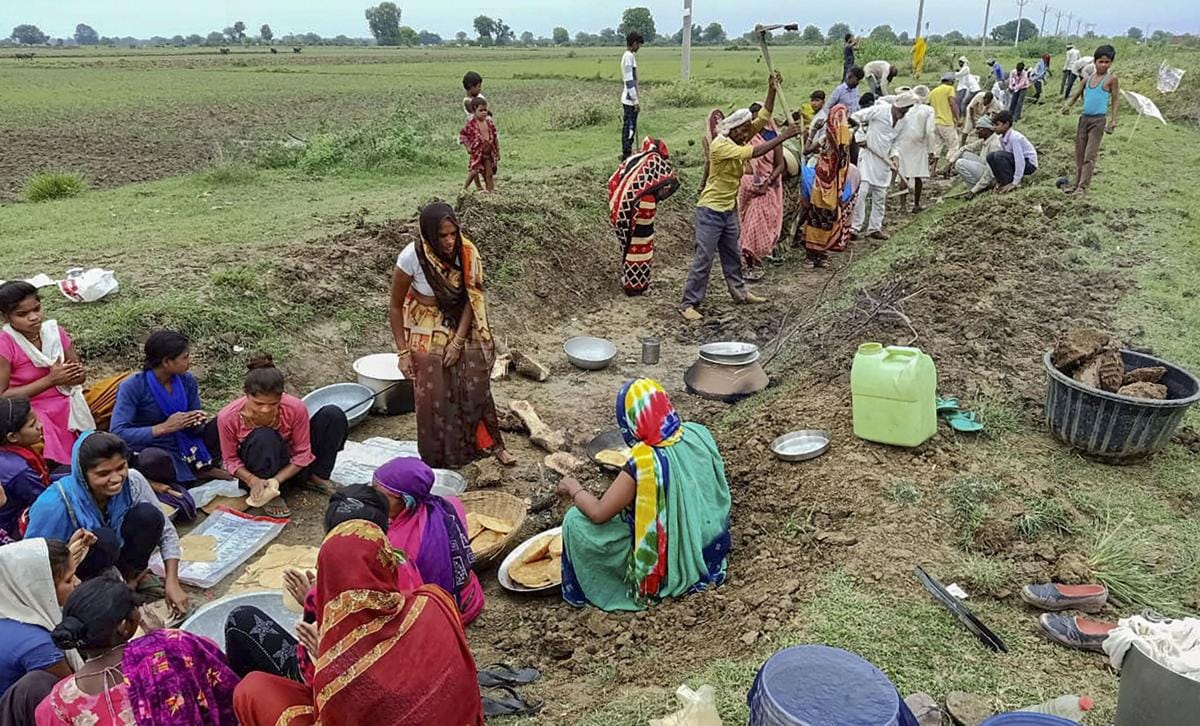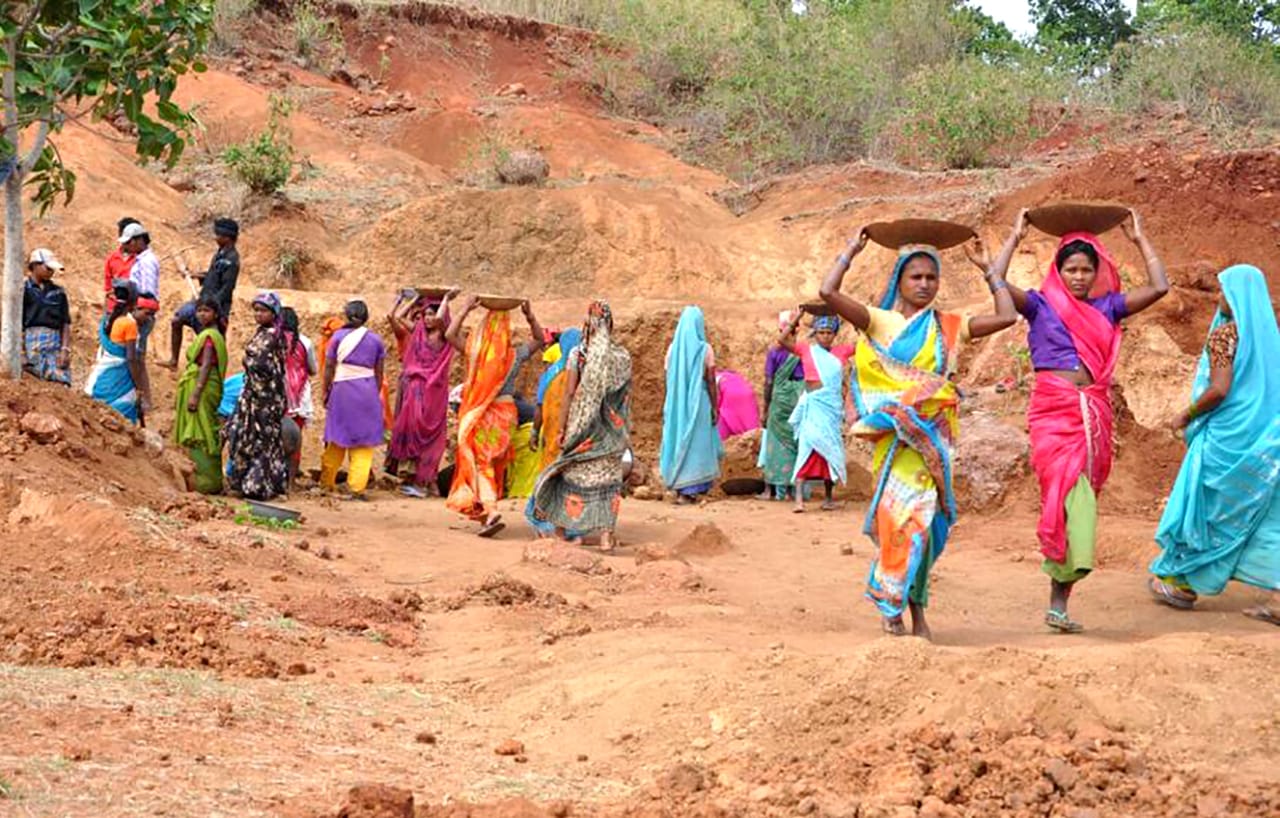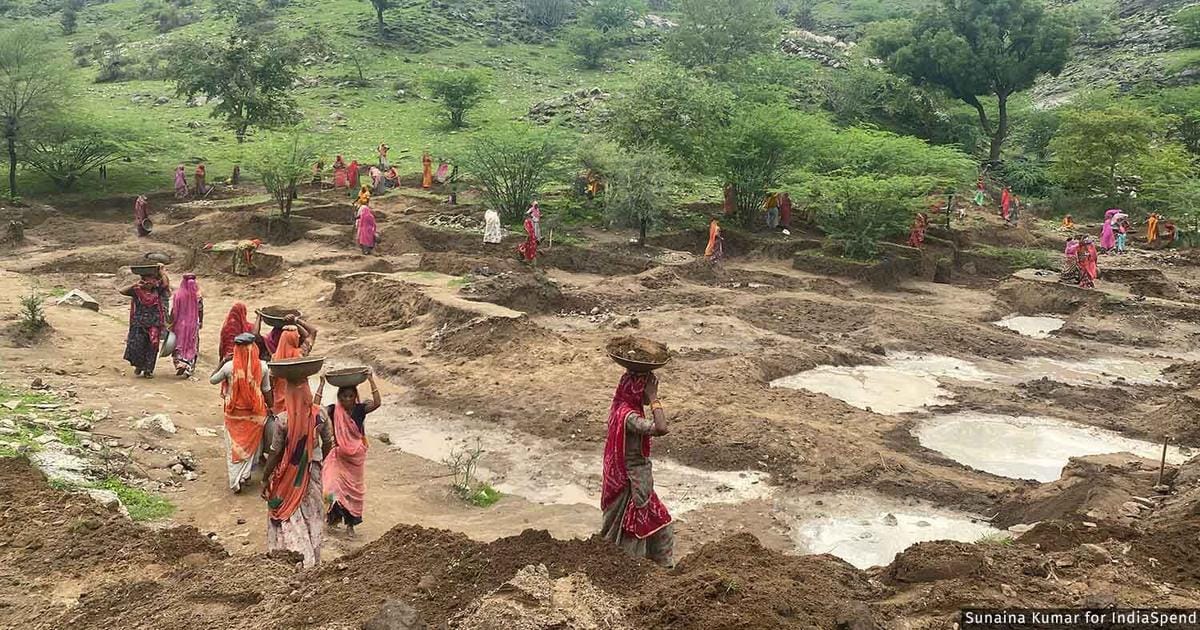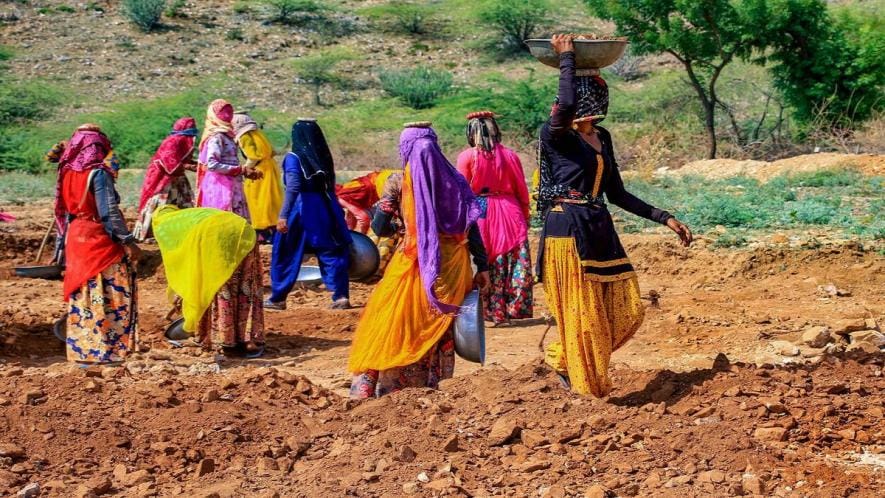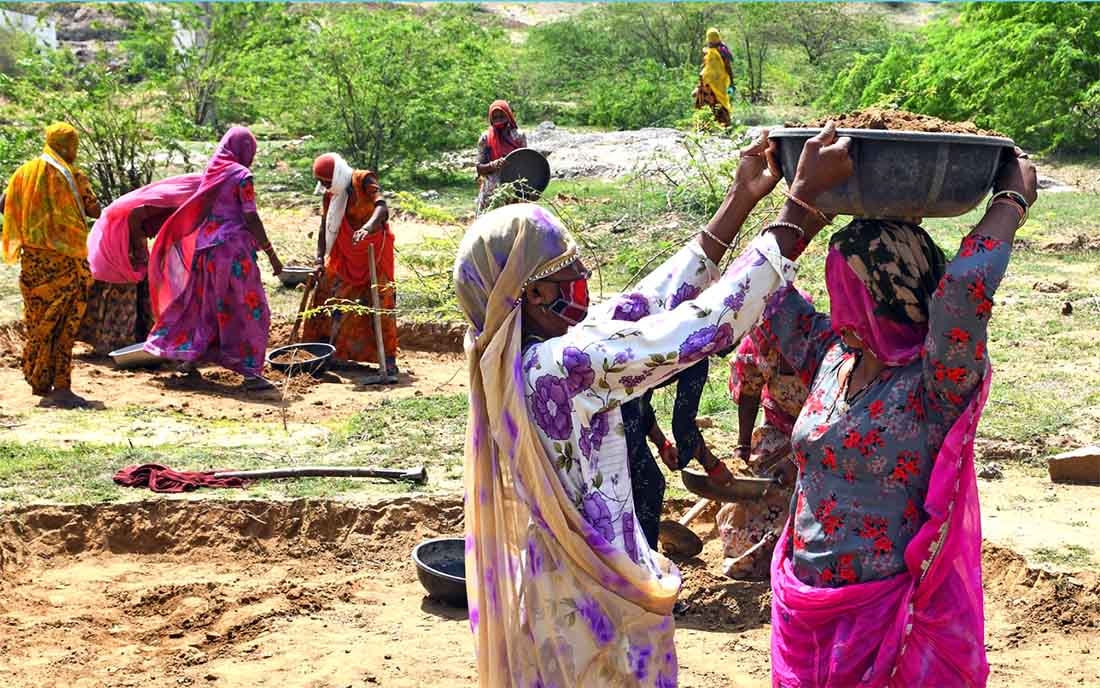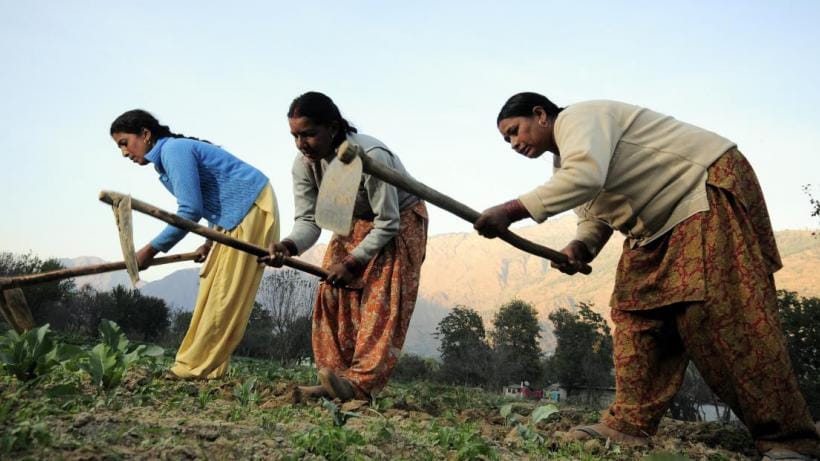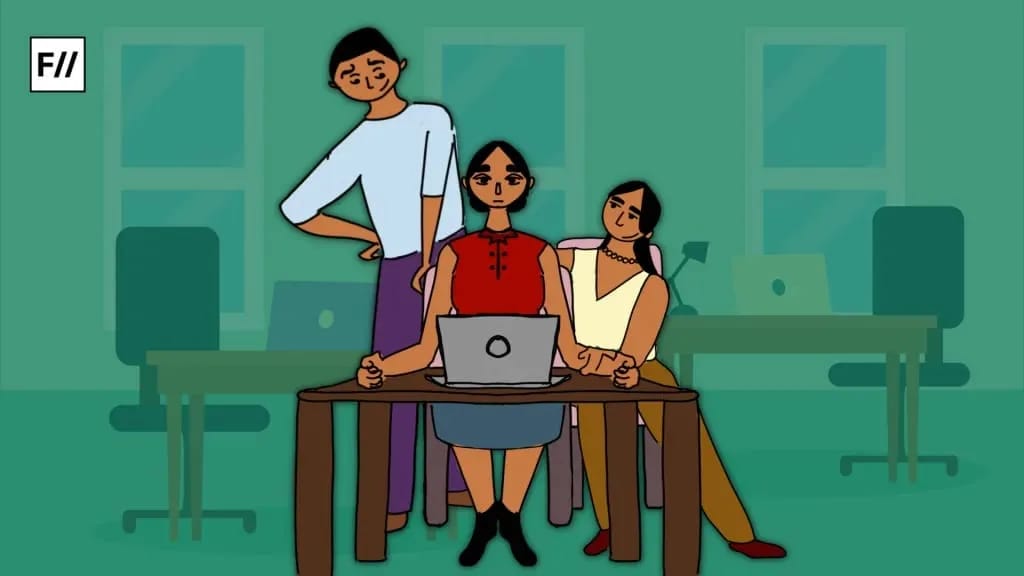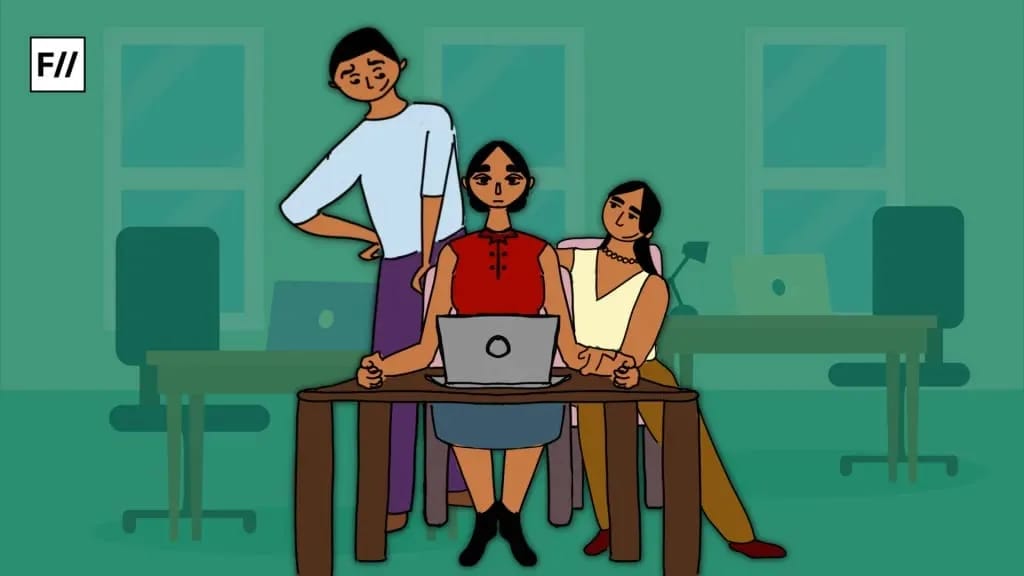‘100-day work is just labour-intensive, such as digging canals or ponds for eight hours a day (without food) for Rs. 271 and is the only available work. After managing the household that includes sourcing raw materials, cooking, feeding children, and doing other household chores, we can’t do such physically demanding work for eight hours at a stretch,‘ said a mother of three in Gosaba Island in Sundarbans in West Bengal in a study Health threats of climate change: from intersectional analysis to justice-based radicalism. The average daily wage rate per person in West Bengal for the fiscal year 2023-24 was Rs. 226 (approximately 2.5 USD) under the Mahatma Gandhi National Rural Employment Guarantee Act, commonly known as MGNREGA, a social welfare program in India that guarantees 100 days of wage employment in a financial year to every rural household whose adult members volunteer to do unskilled manual work. The goal is to enhance livelihood security in rural areas by promoting rural development.
The Sundarbans is the largest mangrove forest in the world, with a unique ecosystem, diverse wildlife, including the Royal Bengal tiger and is a UNESCO World Heritage site. It also houses over 4.5 million people in its Indian parts. These people reside in the biosphere reserve, engaging in activities such as fishing, honey collection, and other forest-based pursuits and face constant threats from natural calamities, particularly cyclones and floods, as well as human-wildlife conflicts with tigers and crocodiles. The latter significantly impacts the lives of local communities, especially women. The problems are worsened by extreme poverty, poor housing, lack of sanitation, limited access to clean drinking water, healthcare and education.
Between 2000 and 2019, India became the third most vulnerable country to natural disasters, after China and the United States. The Sundarbans mangrove forest lies on the delta of the Ganges, Brahmaputra and Meghna rivers on the Bay of Bengal. It is adjacent to the border of India’s Sundarbans World Heritage site, inscribed in 1987. Women often work in fish drying and processing, but this is only available for about four months a year in the area. According to a 2017 study by the Indian Research Journal of Extension Education, more than 50 percent of fisherwomen in the Sunderbans belong to families living in poverty.
The study indicates that approximately 87 percent of the dry fish workers are illiterate. Therefore, flagship government programs like the MGNREGA are expected to help and provide people with better livelihood opportunities in these areas. The objective of the Act is to enhance the livelihood security of the people in the rural areas by generating wage employment through works that develop the infrastructure base of that area.
Women haven’t received wages since 2021 under MGNREGA
As per a fact-finding report covering Purulia, South 24 Paraganas and Nadia by several Civil Society Organizations (CSOs), unions and organisations working on the MGNREGA, women under MGNREGA were not paid wages for the work they had done since November 2021. Non-payment of MGNREGA wages had forced these women to take loans from microfinance institutions. They were charged high rates of interest, such as around 15 to 20 percent, and had to face recovery agents.
Non-availability of MGNREGA work has also resulted in increased unemployment in villages, especially among women workers who generally cannot migrate for work.
Non-availability of MGNREGA work has also resulted in increased unemployment in villages, especially among women workers who generally cannot migrate for work. These difficulties are compounded in the case of single women or widows. In the agricultural off-season, NREGA becomes the only source of work for a large section of the poor and marginalised in rural West Bengal.
MGNREGA jobs don’t align with women’s needs
‘Despite our job cards, there is much favouritism over political colours and bribery,’ said a woman from Lahiripur, one of the most remote inhabited islands in the Sundarbans, in the study Health threats of climate change. Options like crab-catching, on the other hand, offered flexibility for being carried out between 5 am and 10-11 am. ‘We can come back, take a little rest before engaging in the household chores. The return is higher as well,‘ said a woman in Sandeshkhali village who, after working in the MGNREGA for a few days, went back to collecting prawn seedlings and catching crabs.
‘We would have greatly benefitted from it if 100-day work could offer women-friendly work, but it never has,’ said a grandmother in Gosaba who is the custodian of her 13-year-old granddaughter after her son was recently killed in a tiger attack and her daughter-in-law was heavily injured. In West Bengal, women’s participation in MGNREGA has also seen fluctuations over the years.
According to the Ministry of Rural Development, the rate of participation of women was around 45 percent in 2020-21, 47 percent in 2021-22 and 48 percent in 2022-23, whereas it was 67 percent in 2022-23 for Rajasthan and 86 percent in 2022-23 for Tamil Nadu. According to a research paper, “Hard Work, Low Pay: Work Patterns Among Rural Women in West Bengal,” published by Azim Premji University in 2018, for women, very few new occupations have come up.
Agriculture and animal husbandry are still among the top jobs, now ranking 3rd and 4th instead of 2nd and 3rd. However, MGNREGA has become a very important source of employment, even though work is available only for a few days. Earlier, it was the 5th most common job for women, but now it is the 2nd most popular. ‘One major problem with women not benefiting from MGNREGA is also because of a lack of their bank accounts,’ said Smita Sen, Director and Founder of non-profit organisation Rupantaran.
Are MGNREGA jobs aligning with the local needs
As much as 40 percent of the region’s people are engaged in agriculture or allied works, and another 39 percent are into manual or casual labour. But, climate change and heavier monsoons have forced those with landholdings of less than two hectares to migrate, said a report on Sundarbans by the Centre of Financial Accountability.It says 63 percent of the respondents are seasonal migrants, while 22 percent were permanent and 15 percent travelled daily for work elsewhere.
The MGNREGA works with a focus on building agriculture and water-based livelihood options that can provide people with better livelihoods, thereby reducing migration.
The MGNREGA works with a focus on building agriculture and water-based livelihood options that can provide people with better livelihoods, thereby reducing migration. It also mandates that every worker who demands work should be given one within 15 days. While the state government claims the demand for work is decreasing, the government data on demand for work under MGNREGA has seen a significant drop in recent years. As per a report by Down to Earth (DTE), millions of workers in West Bengal have been waiting for work and even wages since 2021.
How MGNREGA is suffering from paucity of funds
The number of total households that completed 100 days of wage employment in the financial year (FY) 2022-23 was 1618, whereas in the FY 2021-22 it was 4,71,136. Average days of employment provided per household were 23.24 in the FY 2022-23 and 21.69 in the FY 2023-24. As per a DTE report, the number of job card holders asking for work was 13,112,389 in 2020-21, 12,242,794 in 2021-22, 2,417,331 in 2022-23 and only 4,443 in 2023-24. Despite orders from the Calcutta High Court to resume MGNREGA in West Bengal by August 1, 2025, the scheme remains inactive.
As per Paschim Banga Khet Majoor Samity (PBKMS), block offices are refusing to accept job applications, leaving rural workers without income or dignity. Between 28th and 31st July 2025, 2092 job applications were submitted across districts, but 1,349 were illegally rejected in 9 block offices. As per PBKMS, workers and activists face threats and intimidation, including communal profiling in some areas.
As per the fact-finding report, the lack of MGNREGA work has increased migration, with up to 80 percent of adult males in some villages leaving for employment. The report also says work provided to households dropped by 79 percent in FY 2022-23, person-days of work generated fell by 90 percent, while wages earned in the first six months of FY 2022-23 dropped by 82 percent.
Politicisation of the scheme and disparities in its implementation
A large number of factors are affecting people’s ability to get employment under MGNREGA. Nandita Jayraman,Program Manager of a non-profit organisation, Mukti, which focuses on the areas of health, education, agriculture, livelihood, among many more in the Sundarbans, said, ‘Embankment repairing in the Sundarbans faces multiple structural and social challenges. There is a very limited scope for engaging with stakeholders, as decision-making is often centralised and lacks transparency. Fund constraints further delay timely repair and maintenance work.’ According to a report by Newsclick, funds from the centrally-sponsored MGNREGA scheme were allegedly used in the construction of an illegal ‘eco-tourism’ resort in the Sunderbans.
According to a report by Newsclick, funds from the centrally-sponsored MGNREGA scheme were allegedly used in the construction of an illegal ‘eco-tourism’ resort in the Sunderbans.
‘The issue, which has now taken a political turn, is leading to polarisation within communities and making constructive dialogue difficult. From a rights-based perspective, discussing equitable access or justice becomes complex due to these issues. There are significant disparities in labour charges across the region, with a clear gender gap. Women are often paid less than men for the same work, despite their equal contribution in manual labour,’ she added.
Talking about the implementation of MGNREGA in India, Apurva Gupta, a researcher with Nrega Sangharsh Morcha, said, ‘States like Rajasthan, Karnataka, Haryana, Tamil Nadu and Andhra Pradesh have MGNREGA wages higher than the minimum agricultural wages. There are some states like Bihar and Jharkhand where MGNREGA wages are lower than the minimum agricultural wages. There is a delay in the compensation as well. Funds are not reimbursed on time, and wages are so low that it works in some states while it doesn’t in others. Additionally, some states have more flexible laws and guidelines for labourers. For instance, in Karnataka during the summer, attendance is recorded for only one day to ensure that workers have reduced workloads. The measurement of the pit they are required to dig is also smaller. In contrast, in states like Bihar and Jharkhand, this measurement is much larger. This means that in Karnataka, workers can earn higher wages for less work in a day during the summer, whereas in Bihar and Jharkhand, they earn lower wages despite doing more work. Rajasthan also has similar provisions.’
Talking about West Bengal, she added, ‘It was also one of the top states where MGNREGA used to work well. Now it has become defunct. Since funds are not coming, it has now completely stopped.’
MGNREGA is also a political instrument
In recent years, MGNREGA has become a source of political tension between the West Bengal government, led by the Trinamool Congress (TMC), and the central government. The main issue has been the Centre’s decision to suspend the release of MGNREGA funds to the state. On March 9, 2022, the Central government issued an order freezing the transfer of funds for the MGNREGS for West Bengal, citing irregularities in implementation. The Union Rural Development Minister, Shivraj Singh Chouhan, stated that this action was taken due to the state’s non-compliance with mandated guidelines and alleged irregularities in the scheme’s implementation.
He emphasised that the suspension is not discriminatory and that funds will be released once the state adheres to the required directives. In December 2021, the central government suddenly invoked Section 27 of the Mahatma Gandhi National Rural Employment Guarantee Act and stopped funds for the scheme. It then stopped commissioning work under the Act in 2022. Since then, no labour budget has been approved for West Bengal for 2023-24 and 2024-25 under the scheme. In September 2024, the Calcutta High Court observed that the scheme must continue to operate even while the irregularities are investigated. In response, West Bengal Chief Minister Mamata Banerjee claimed that the state is being penalised for its exemplary performance in implementing MGNREGA.
MGNREGA couldn’t prevent migration for work
A study named “Employment Guarantee and Natural Vulnerability” examined MGNREGA in the context of the Indian Sundarbans, particularly after Cyclone Aila in 2009. Post-Aila, MGNREGA activities shifted focus from farm-related projects like water conservation and irrigation to flood control and rural connectivity. This change aimed to rebuild embankments and infrastructure damaged by the cyclone. Employment days under MGNREGA increased after Aila, rising from an average of 11 days per person in 2008 to 18 days in 2009 and 20 days in 2010.
Employment days under MGNREGA increased after Aila, rising from an average of 11 days per person in 2008 to 18 days in 2009 and 20 days in 2010.
However, this increase was insufficient to meet the demand for work in the affected areas. Many asset-poor households opted for migration rather than participating in MGNREGA due to subsistence constraints and inadequate program outreach. Migration was predominantly interstate, with workers moving to southern states like Tamil Nadu and Karnataka. It also showed that households with higher fixed assets (e.g., land) were more likely to participate in MGNREGA, leveraging their social networks to access the program. Despite the increased need for employment, the total allocation for MGNREGA in Khulna Gram Panchayat, where the study was carried out, declined in absolute terms after Aila.
Migration remains a serious issue, indicating that MGNREGA has not been able to prevent it. When individuals migrate out to work, the women are often left behind, which only adds to their social and economic issues. ‘Though there is wage discrimination for both male and female workers compared to other states, the MGNREGA calculation is different from most other states, because of which the payment is lower,‘ added Nandita. The trend is different in this case, and hence MGNREGA is not sufficient to prevent the persistent migration for livelihood.
These issues make the implementation a social and political activity. It has been observed in a study of the Sagar Islands that inadequate irrigation facilities lower agricultural output. Natural resources are not being utilised to their full extent due to poor awareness. Marginalised groups, particularly SC/ST communities, suffer from uneven socio-economic growth. Apart from that, political bias in the distribution of work under MGNREGA makes things even tougher.
The Sundarbans story reflects a complex setting of climatic vulnerability, gender inequity, political unrest and administrative inefficiency. As elaborate as plans like MGNREGA were designed to be instruments of ensuring livelihood security and rural resilience, their implementation in ecologically fragile and socio-politically sensitive regions like the Sundarbans reflects deep-seated gaps. Women, being at the forefront of both climate survival and informal work, are still not served, forced to low-wage, back-breaking employment with no institutional support.
Politicisation of the MGNREGA scheme, delayed payment of wages, and lack of women-led planning compound their misfortune. For actual effect, policy implementation should be based on lived realities, especially of the most marginalised and complemented with committed funding, gender-sensitive employment opportunities, and transparency at all levels. It is only when this happens that the vision of decent rural employment and climate justice can truly touch the last person in the Sundarbans.
